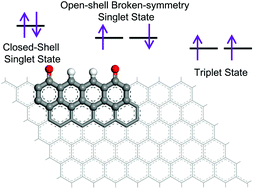当前位置:
X-MOL 学术
›
Phys. Chem. Chem. Phys.
›
论文详情
Our official English website, www.x-mol.net, welcomes your
feedback! (Note: you will need to create a separate account there.)
Magnetism-tuning strategies for graphene oxide based on magnetic oligoacene oxide patches model†
Physical Chemistry Chemical Physics ( IF 2.9 ) Pub Date : 2018-01-02 00:00:00 , DOI: 10.1039/c7cp06405e Yanjie Wen,Chia-Liang Yen,Linyin Yan,Hirohiko Kono,Sheng-Hsien Lin,Yong-Chien Ling
Physical Chemistry Chemical Physics ( IF 2.9 ) Pub Date : 2018-01-02 00:00:00 , DOI: 10.1039/c7cp06405e Yanjie Wen,Chia-Liang Yen,Linyin Yan,Hirohiko Kono,Sheng-Hsien Lin,Yong-Chien Ling

|
Graphene oxide (GO) has wide application potential owing to its 2D structure and diverse modification sites for various targeted uses. The introduction of magnetism into GO structures has further advanced the controllability of the application of GO materials. Herein, the concept of modular design and modeling was applied to tune the magnetism of GO. To obtain desirable magnetic properties, diradical-structured GO patches were formed by the introduction of two functional groups to break the Kekule structure of the benzene ring. In these diradical GO patches, the energy of the triplet state was lower than those of the open-shell broken-symmetry singlet state and closed-shell singlet state. To create such multi-radical patches, a practical approach is to determine a substantial spatial separation of the α and β spin densities in the molecule. Thus, systematic design strategies and tests were evaluated. The first strategy was extending the distance between the distribution center of the α and β spin densities; the second was controlling the delocalization directions of the α and β electrons; the third was controlling the delocalization extension of the α and β electrons by oxidative modification, and finally introducing multi-radical structures into the molecular system and controlling the position of each radical. Herein, successful molecular models with a large magnetic coupling constant (∼3600 cm−1) were obtained. This study paves the way to explore ferromagnetic MGO guided by theoretical study, which may become reality soon.
中文翻译:

基于磁性低聚氧化丙烯斑模型的氧化石墨烯的磁性调谐策略†
氧化石墨烯(GO)由于其2D结构和针对各种目标用途的多种修饰位点而具有广泛的应用潜力。将磁性引入GO结构进一步提高了GO材料应用的可控性。在这里,模块化设计和建模的概念被应用于调整GO的磁性。为了获得所需的磁性能,通过引入两个官能团以破坏苯环的Kekule结构来形成双自由基结构的GO贴片。在这些双基GO补丁中,三重态的能量低于开壳破碎对称单重态和闭壳单重态的能量。为了产生这样的多自由基补丁,一种实用的方法是确定分子中α和β自旋密度的基本空间间隔。因此,评估了系统的设计策略和测试。第一种策略是延长α和β自旋密度分布中心之间的距离。第二个是控制α和β电子的离域方向。第三是通过氧化修饰控制α和β电子的离域扩展,最后将多自由基结构引入分子系统并控制每个自由基的位置。在此,成功的分子模型具有大的磁耦合常数(〜3600 cm 第三是通过氧化修饰控制α和β电子的离域扩展,最后将多自由基结构引入分子系统并控制每个自由基的位置。在此,成功的分子模型具有大的磁耦合常数(〜3600 cm 第三是通过氧化修饰控制α和β电子的离域扩展,最后将多自由基结构引入分子系统并控制每个自由基的位置。在此,成功的分子模型具有大的磁耦合常数(〜3600 cm获得-1)。本研究为理论研究指导下的铁磁MGO的探索铺平了道路,有望很快成为现实。
更新日期:2018-01-02
中文翻译:

基于磁性低聚氧化丙烯斑模型的氧化石墨烯的磁性调谐策略†
氧化石墨烯(GO)由于其2D结构和针对各种目标用途的多种修饰位点而具有广泛的应用潜力。将磁性引入GO结构进一步提高了GO材料应用的可控性。在这里,模块化设计和建模的概念被应用于调整GO的磁性。为了获得所需的磁性能,通过引入两个官能团以破坏苯环的Kekule结构来形成双自由基结构的GO贴片。在这些双基GO补丁中,三重态的能量低于开壳破碎对称单重态和闭壳单重态的能量。为了产生这样的多自由基补丁,一种实用的方法是确定分子中α和β自旋密度的基本空间间隔。因此,评估了系统的设计策略和测试。第一种策略是延长α和β自旋密度分布中心之间的距离。第二个是控制α和β电子的离域方向。第三是通过氧化修饰控制α和β电子的离域扩展,最后将多自由基结构引入分子系统并控制每个自由基的位置。在此,成功的分子模型具有大的磁耦合常数(〜3600 cm 第三是通过氧化修饰控制α和β电子的离域扩展,最后将多自由基结构引入分子系统并控制每个自由基的位置。在此,成功的分子模型具有大的磁耦合常数(〜3600 cm 第三是通过氧化修饰控制α和β电子的离域扩展,最后将多自由基结构引入分子系统并控制每个自由基的位置。在此,成功的分子模型具有大的磁耦合常数(〜3600 cm获得-1)。本研究为理论研究指导下的铁磁MGO的探索铺平了道路,有望很快成为现实。











































 京公网安备 11010802027423号
京公网安备 11010802027423号